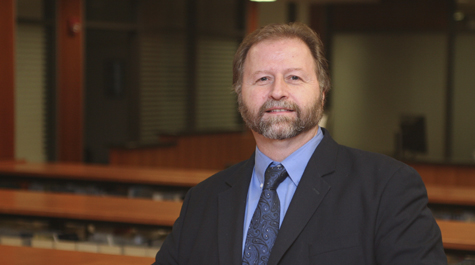Legal aid: Darryl Cunningham helps LL.M. students turn theory into practice
Clinics and internships play a key role in helping law students put their newly acquired legal knowledge and skills into practice. But for many LL.M. students, the transition from student to lawyer also requires mastering a new language and a new culture.
Since 2009, Professor Darryl Cunningham has helped approximately a dozen LL.M. students face these challenges head on. He has worked with them at his Family Law clinic and at the Williamsburg office of the Legal Aid Society of Eastern Virginia, where he is a senior attorney.
“Professor Cunningham has been very generous with his time and energy to give our LL.M. students these opportunities,” said Professor Jennifer Stevenson, the Associate Director of the LL.M. program. “Practical skills really gel when working with legal aid or in the clinics, and this gives them an opportunity to be on an even ground with J.D. students.”
Agata Przekop, a Class of 2016 LL.M. graduate from Poland, discovered this while working in Cunningham’s Family Law clinic during the spring semester of 2016.
“I think that working in a clinic is the best way to learn law,” she said. “You can study entire code sections and procedural aspects, but before you can apply it in real life, it is just theory.”
Przekop said that she enjoyed her experience so much that she asked Cunningham if she could volunteer full-time at the Legal Aid Society during the summer. He agreed.
“I have only good things to say about Professor Cunningham,” she said. “He is not only a very good attorney, but also a very good teacher.”
Przekop said that Cunningham involved her in virtually all aspects of cases, from interviewing clients to drafting legal documents. She also appreciated that his hands-off approach as a supervisor was motivated by a desire to help students figure things out by themselves.
“If there are general tasks, like dealing with a client, you have to suggest what steps to take,” she said. “When I was assigned to a case, he would give me a file, and the initial job was read through the file and figure out what to do next.”
However, he would regularly sit down with students and give them a lot of helpful feedback about their work. Przekop recalled having daily conversations with Cunningham and regularly approaching him with questions about her work.
“We could always knock on his door and come in and talk,” she said. “He was very open.”
Cunningham said that one of the biggest challenges with LL.M. students has to do with language. Although every student is fluent in English, many are not used to writing in formal legalese.
He said that he edits each drafted document and discusses them with each student. Although initial documents often require a considerable amount of editing, he said that students get used to the legal writing required in the clinic by the end of the semester.
This process was very helpful for Przekop, who is not a native English speaker.
In addition to adjusting to a new language, many LL.M. students are also adjusting to the practice of law in a new culture. LL.M. students have previously studied the law, and many have practiced law in their home countries.
“This gives them a different perspective,” said Stevenson. “Our norms on marriage, divorce, and family law are so culturally embedded that someone who grew up in the U.S. may see things one way, while others may see things differently.”
But far from being a barrier to success, the linguistic and cultural diversity of LL.M. students often comes with benefits, particularly when working with clients who are themselves from abroad. Cunningham recounted working with a client who was a Chinese woman seeking a divorce.
“It just happened that a Chinese LL.M. student in our Family Law Clinic was the next in line for that client,” he said, adding that it enabled her to speak in their client’s native language. “That made things very smooth, and it was nice for her to be comfortable.”
Cunningham said that he has enjoyed working with LL.M. students and plans to continue working with them.
“Their work product and work ethic has always been very good,” Cunningham said. “They work very hard and are very interested in learning more.”
Ultimately, the experience was very helpful for Przekop. She recently graduated from the LL.M. program and is currently seeking admission to the Law School’s J.D. program.
“He really likes what he is doing and he cares deeply about every client,” she said of Cunningham. “Because of his approach, you want to work with him, and it creates an atmosphere where you know you are doing something good.”
















